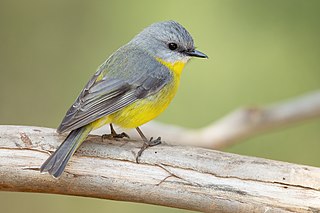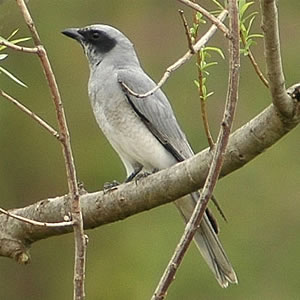
A passerine is any bird of the order Passeriformes, which includes more than half of all bird species. Sometimes known as perching birds or songbirds, passerines are distinguished from other orders of birds by the arrangement of their toes, which facilitates perching.

A songbird is a bird belonging to the clade Passeri of the perching birds (Passeriformes). Another name that is sometimes seen as the scientific or vernacular name is Oscines, from Latin oscen, "a songbird". The group contains 5000 or so species found all over the world, in which the vocal organ typically is developed in such a way as to produce a diverse and elaborate bird song.

Currawongs are three species of medium-sized passerine birds belonging to the genus Strepera in the family Artamidae native to Australia. These are the grey currawong, pied currawong, and black currawong. The common name comes from the call of the familiar pied currawong of eastern Australia and is onomatopoeic. They were formerly known as crow-shrikes or bell-magpies. Despite their resemblance to crows and ravens, they are only distantly related to the corvidae, instead belonging to an Afro-Asian radiation of birds of superfamily Malaconotoidea.

The family Vangidae comprises a group of often shrike-like medium-sized birds distributed from Asia to Africa, including the vangas of Madagascar to which the family owes its name. Many species in this family were previously classified elsewhere in other families. Recent molecular techniques made it possible to assign these species to Vangidae, thereby solving several taxonomic enigmas.

The cuckooshrikes and allies in the family Campephagidae are small to medium-sized passerine bird species found in the subtropical and tropical Africa, Asia and Australasia. The 93 species are divided into 11 genera. The woodshrikes (Tephrodornis) were often considered to be in this family but are now placed in their own family, Vangidae, along with the philentomas and the flycatcher-shrikes. Another genus, Chlamydochaera, which has one species, the black-breasted fruithunter, was often placed in this family but has now been shown to be a thrush (Turdidae).

The bushshrikes are smallish passerine birds. They were formerly classed with the true shrikes in the family Laniidae, but are now considered sufficiently distinctive to be separated from that group as the family Malaconotidae, a name that alludes to their fluffy back and rump feathers.

The Bornean bristlehead, also variously known as the bristled shrike, bald-headed crow or the bald-headed wood-shrike, is the only member of the passerine family Pityriasidae and genus Pityriasis. It is an enigmatic and uncommon species of the rainforest canopy of the island of Borneo, to which it is endemic.

The Cracticinae, bellmagpies and allies, gathers together 12 species of mostly crow-like birds native to Australasia and nearby areas.

Woodswallows are soft-plumaged, somber-coloured passerine birds in the genus Artamus. The woodswallows are either treated as a subfamily, Artaminae, in an expanded family Artamidae, or as the only genus in that family. The generic name, which in turn gives rise to the family name, is derived from the Ancient Greek artamos, meaning butcher or murder. The name was given due to their perceived similarity to shrikes. A former common name for the group was "swallow-starlings".
A shrike is a passerine bird of the family Laniidae.

Cracticus is a genus of butcherbirds native to Australasia. They are large songbirds, being between 30 and 40 cm (12–16 in) in length. Their colour ranges from black-and-white to mostly black with added grey plumage, depending on the species. They have a large, straight bill with a distinctive hook at the end which is used to skewer prey. They have high-pitched complex songs, which are used to defend their essentially year-round group territories: unlike birds of extratropical Eurasia and the Americas, both sexes sing prolifically.

The pygmy cuckooshrike is a species of bird in the cuckooshrike family Campephagidae. It is endemic to the Indonesian island of Sulawesi. Its natural habitat is subtropical or tropical moist montane forests.

The blue cuckooshrike is a species of bird in the Cuckooshrike family, Campephagidae. It is found from Sierra Leone and Liberia to eastern and south-western Democratic Republic of Congo. Its natural habitats are subtropical or tropical dry forests and subtropical or tropical moist lowland forests.

McGregor's cuckooshrike or the sharp-tailed cuckooshrike is a species of bird in the family Campephagidae. It is endemic to Mindanao island (Philippines).

The black-backed butcherbird is a species of bird in the family Artamidae. It is found in southern New Guinea and Cape York Peninsula.

Peltops is a genus of birds in the family Artamidae. It contains two species that are endemic to the island of New Guinea. The species have also had the common name of shieldbill.
Artamidae is a family of passerine birds found in Australia, the Indo-Pacific region, and Southern Asia. It includes 24 extant species in six genera and three subfamilies: Peltopsinae, Artaminae and Cracticinae. Artamids used to be monotypic, containing only the woodswallows, but it was expanded to include the family Cracticidae in 1994. Some authors, however, still treat the two as separate families. Some species in this family are known for their beautiful song. Their feeding habits vary from nectar sucking (woodswallows) to predation on small birds.
Kurrartapu johnnguyeni is an extinct species of bird in the Australian magpie and butcherbird family. It was described from Early Miocene material found at Riversleigh in north-western Queensland, Australia. It is the first Tertiary record of a cracticid from Australia. The size of the fossil material indicates that it was similar in size to the living black butcherbird. The generic name is a Kalkatungu language term for the Australian magpie. The specific epithet honours John Nguyen, the father of the senior describer.

Ceblepyris is a genus of African passerine birds in the cuckooshrike family Campephagidae.
















